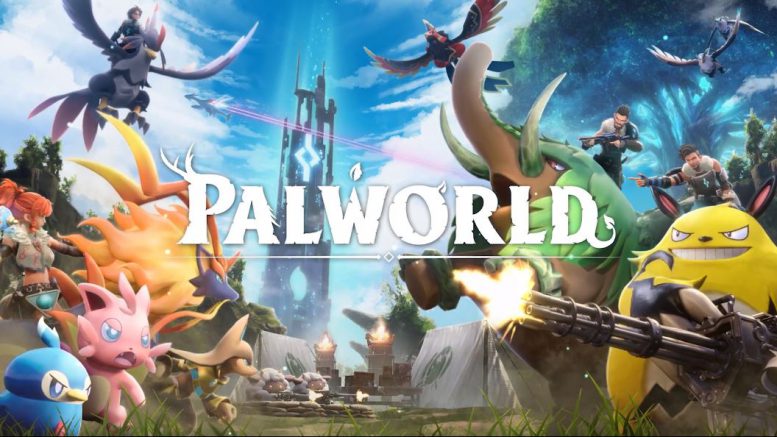By Justin Kopp ’25, staff writer
Revealed on June 5, 2021, Japanese developer Pocket Pair’s “Palworld” affectionately came to be known as “Pokémon with guns” by many observers of the gaming industry because of the game’s main selling point—creatures called Pals. Survival in this open-world survival game depends on a player’s relationship with their Pals in a mash-up that, upon further inspection, has more accurately been dubbed “ARK: Survival Evolved with Pokémon.”
Whether they chose to capture, breed, kill, eat, arm them with firearms or employ them in every manner of forced labor, the game’s playerbase quickly fell in love with its myriad of critters. Released in early access on Steam on Jan. 19, 2024, the game sold eight million copies within six days of release. By Feb. 22, 2024, Pocket Pair announced that it had sold 15 million copies on Steam and saw 10 million players on Xbox Game Pass.
Now that many players like myself have wrapped up their first playthroughs, it is possible to take a more wholistic look at the game and dig past the buzz to find out what makes “Palworld” worth playing past the 15-hour mark.
Opinions on the Pals’ designs have landed anywhere between charming to uninspired, but the variety of good, useful Pals’ is indisputable. This is made possible by Partner Skills, special abilities that vary by species.
Many adorable yet weak-looking Pals have an ability that boosts the power of Pals that share an element with them. These abilities ensure that cuter Pals like Cremis and Rooby can stay useful after a player has captured more powerful partners.
Another group of Partner Skills revolves around Pals that cause defeated opponents to drop more materials. The Pals that have them are not the fastest mounts or commonly mounts at all, but their skills kept some of the better designed Pals, like Orserk and Blazehowl, from being relegated to my Pal Box after I caught the game’s Legendary Pals.
Speaking of Legendary Pals, Pocket Pair certainly made them live up to their reputation. Boasting a grand shared boss theme, their power is demonstrable by anything short of a rocket launcher failing to make a dent in their titanic health stats. They do not get nerfed after being captured either, so players are free to abuse their strength after a hard-fought battle.
Movement in the game is also highly diverse and satisfying. Grappling guns, slides, climbing, gliding and swimming ensure that players can tackle whatever their environment throws at them. Most of the time, however, players will be using a variety of the mountable Pals available to them to travel.
Mounts have increased land speed and may have multiple jumps or flight capabilities. Many have combat effects as well, such as boosting damage or converting player damage to an Element. Pals can be used in place of gliders for special effects too. Galeclaw is the most common choice for its speed and the ability to wield a ranged weapon while using it, but others like Hangyu offer more vertical mobility.
Swimming Pals are the only group where the game falls completely flat. Infinite sprint stamina in water is not enough to make up for their overall low travel speed, so it is better to fly. This is especially true when one risks glitching through the ocean and dying, a not entirely unexpected occurrence given that the game is in early access.
In contrast to the colorful roster of Pals, the world part of “Palworld” can get bland. Unique areas like the volcano are quite vibrant, but a significant chunk of the map consists of the beginner beach or forest areas and the starting Pals that come with them. This could be a necesary consequence of needing to support multiple players on a finite map, but it reduces the player’s incentive to explore significantly.
There is also an apparent lack of friendly NPC life in the world. There are only three towns on the entire map, and they all house similar vendors with little else going on. There are ruined castles and enormous techno-structures scattered across the map too, but they are disappointingly inactive save for the areas’ usual Pals.
The world’s other inhabitants are all hostile criminals and eco-terrorists, and raiding the same styles of camp gets old quickly. This is exacerbated by the open-air design of the camps, making it very easy to bypass the few fortifications and rescue the single captured Pal.
As for the future of “Palworld,” it is admirable that Pocket Pair is being responsible and addressing performance issues and bugs before attempting to churn out new content. It may be quite the wait, but the developer’s roadmap has a host of forthcoming features listed such as PVP and raid bosses in addition to new Pals, items and islands.
Given the enthusiasm of the player base, a simple infusion of more places to see, new things to do and more people to meet will surely pull players back into “Palworld’s” orbit. Time can only tell if in a few years’ time, when the game is complete, players are satisfied by the rich ecosystem Pocket Pair has developed, or if they are longing for the follow-up to what was an immensely immersive launch.
